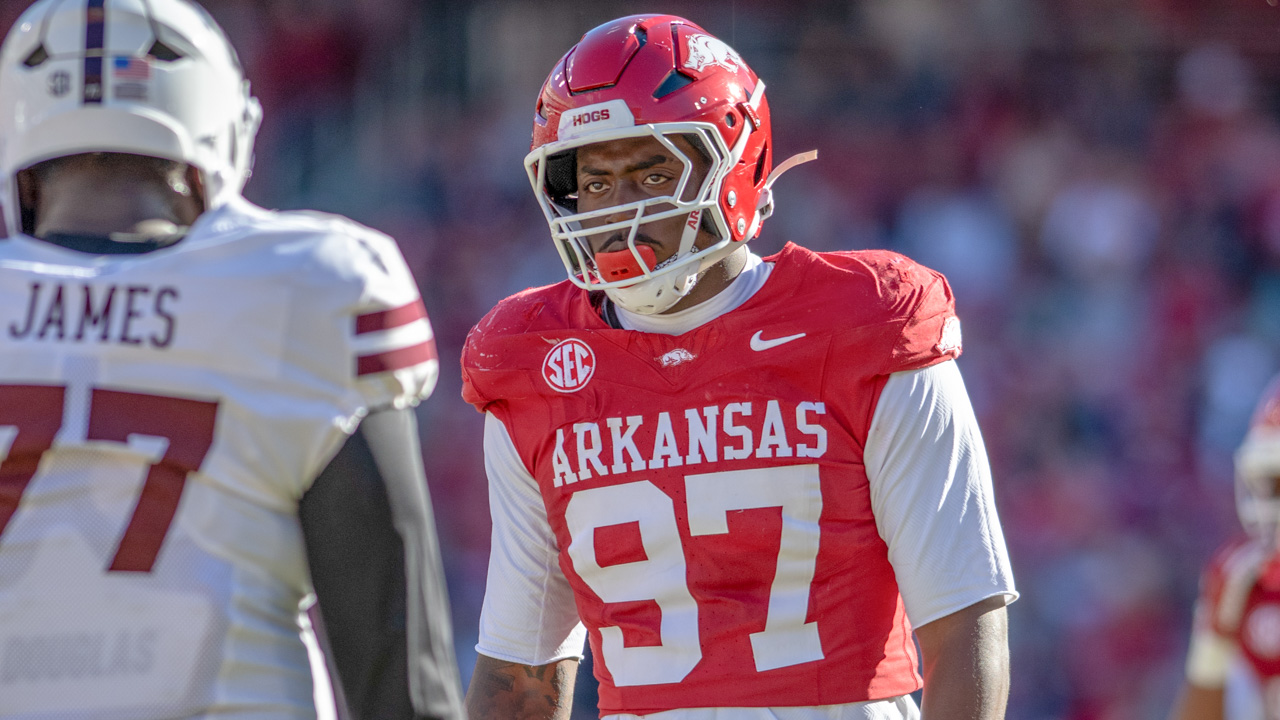Hogs Football
Quincy Rhodes Jr. gaining NFL-edge buzz as Arkansas defensive end
Arkansas junior Quincy Rhodes Jr. shows the size, burst and production that fit what NFL teams want in a defensive end

FAYETTEVILLE, Ark. — Arkansas junior defensive end Quincy Rhodes Jr. is drawing attention for the way he looks and plays the position.
A draft analyst says he fits the mold of an NFL defensive end and points to both his frame and his production this season.
Rhodes stands 6-foot-6 and weighs 275 pounds. He arrived at fall camp ready to step into a larger role after an edge star moved on. He did not shy from the moment, saying he was prepared to meet the standard he set for himself.
“Now, with Landon gone I feel like it’s my time,” Rhodes said in August. “So I’ve just got to live up to expectations and expectations on myself.”
He has backed up that claim during the first nine games. After starting only once in his first two seasons, he has started eight times this fall. The uptick in snaps has brought a surge in production and routine backfield stops.
Rhodes is tied for the SEC lead with 14 tackles for loss and tied for second with eight sacks. That impact has come even as Arkansas has struggled in league play.
A breakout performance came in a recent loss to Mississippi State. Rhodes had 4.5 tackles for loss, the most by an SEC defender this year and the first such single-game total for an Arkansas player since 2005.
He also logged four or more tackles for loss in another game this season, against Memphis on Sept. 20. He is the first Razorback to do that twice in one season.
Ryan Roberts, an NFL and college football analyst with A to Z Sports, told HawgBeat the tape shows traits that translate to Sundays. He highlighted Rhodes’ length, burst and the way those tools now pair with results.
“He just had a terror of the game in the past week and has been playing really good ball,” Roberts said. “You can’t teach 6-foot-6, 270, long arms, explosive. He’s got all those traits and to see the production back it up is obviously a really big thing.
“When you talk about what an NFL defensive end looks like, a 4-3 hand in the dirt type of guy, that is Quincy”
Projection and skill growth
Roberts said Rhodes has a fast get-off that forces blockers to react.
He added that Rhodes’ hands are getting quicker and stronger as the season goes on, which helps him escape blocks and finish plays.
There is still room to improve. Roberts noted that some of the next steps come with reps and awareness in the run game.
He said Rhodes can expand his pass-rush plan with more inside counters and other finishing moves.
“The biggest improvements are mostly with lack of experience,” Roberts said. “The awareness in the run game is a little bit up and down at times.” He suggested adding a rip, club-rip and swim to complement his long-arm wins.
Roberts believes Rhodes’ physical makeup also gives coaches options. He said Rhodes can reduce inside on passing downs or rush from wider alignments, depending on the call and matchup.
The praise comes during a difficult stretch for Arkansas. The Razorbacks have lost seven straight and are the only SEC team without a conference win.
Even so, Rhodes has been a steady source of disruption.
Defensive numbers across the board have lagged, but recent run defense has shown signs of improvement.
Depth challenges inside have made Rhodes’ consistency on the edge even more notable for the unit.
Rhodes’ rise has also changed how evaluators discuss his future.
Entering the season, he was more of a wait-and-see player. Now, the conversation has shifted to where he might fit in the next draft cycle.
Roberts projects Rhodes as at least a top-50 player if he declares, putting him in the early second round with a chance to go even higher. Character checks and the pre-draft process will matter, he added.
If Rhodes is selected in the top 50, he would be Arkansas’ highest-drafted defensive lineman since Jamaal Anderson went No. 8 in 2007. Recent rankings also list Rhodes among the nation’s top edge prospects for 2026.
For now, Rhodes keeps adding to a season that pairs traits with results.
Each week offers more film of a long, explosive end who is learning fast and finishing plays behind the line.
What it means for Arkansas and the draft
For Arkansas, Rhodes’ development offers a building block on a defense seeking stability.
His presence on the edge helps set the front, even as coaches manage injuries and depth inside.
For NFL teams, the profile is clear: length, first-step burst and emerging technique.
The next phase is stackable — continue improving run fits, expand rush counters and keep converting pressures into drive-killing plays.
Roberts summed up the appeal: the unteachable tools are there, and the production is catching up. That combination is why he views Rhodes as an early selection if he enters the draft.
Rhodes’ coaches and teammates will look for more of the same down the stretch. If the trend continues, his tape will show a player who grew from a role piece into a reliable finisher.
The story of this season, for Rhodes, is opportunity met with performance. It has also given scouts a clearer view of how his skills fit a pro scheme.
As the regular season closes, the conversation shifts to decisions. Whether he stays or goes, Rhodes has raised his profile and provided a bright spot for the Razorbacks.
Key takeaways:
- Quincy Rhodes Jr. matches the NFL defensive end prototype with length, burst and growing technique.
- Production jump includes 14 tackles for loss and eight sacks with multiple 4+ TFL games.
- Analyst projects at least top-50 draft range, with room to climb as skills expand.













